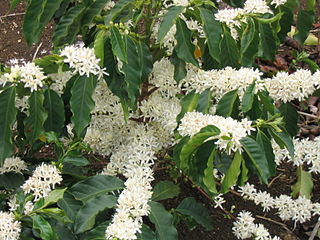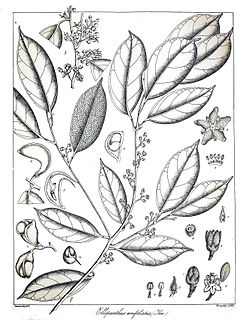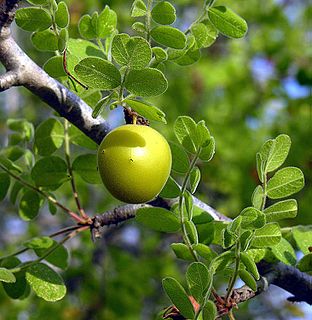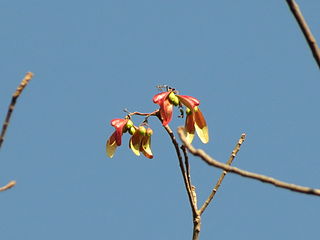
Coffea is a genus of flowering plants in the family Rubiaceae. Coffea species are shrubs or small trees native to tropical and southern Africa and tropical Asia. The seeds of some species, called coffee beans, are used to flavor various beverages and products. The fruits, like the seeds, contain a large amount of caffeine, and have a distinct sweet taste and are often juiced. The plant ranks as one of the world's most valuable and widely traded commodity crops and is an important export product of several countries, including those in Central and South America, the Caribbean and Africa.

Mangifera is a genus of flowering plants in the cashew family, Anacardiaceae. It contains approximately 69 species, with the best-known being the Common Mango. The center of diversity is in subtropical and tropical South Asia and Southeast Asia, while the highest number of species occur in India. They are generally canopy trees in lowland rainforests, reaching a height of 30–40 m (98–131 ft).

Palaquium is a genus of about 120 species of trees in the family Sapotaceae. Their range is from India across Southeast Asia, Malesia, Papuasia and Australasia, to the western Pacific Islands.

The Styracaceae are a small family of flowering plants in the order Ericales, containing 12 genera and about 160 species of trees and shrubs. The family occurs in warm temperate and subtropical regions of the Northern Hemisphere.
Erismanthus is a plant genus of the family Euphorbiaceae first described as a genus in 1866. It is native to Southeast Asia and southern China.
- Erismanthus obliquusWall. ex Müll.Arg. - S Thailand, Malaysia, Borneo, Sumatra
- Erismanthus sinensisOliv. - Cambodia, Laos, Thailand, Vietnam, Hainan
Galearia is a genus of plant of the family Pandaceae. It is native to Indochina, insular Southeast Asia, New Guinea and the Solomon Islands. They are large trees or shrubs which exude a white liquid.

Dillenia is a genus of about 100 species of flowering plants in the family Dilleniaceae, native to tropical and subtropical regions of southern Asia, Australasia, and the Indian Ocean islands.
Heliciopsis is a genus of about thirteen species of trees, constituting part of the flowering plant family Proteaceae. They grow naturally in Burma, Indo-China, SE. China, Thailand, Peninsular Malaysia, Borneo, Sumatra, Java (Indonesia) and the Philippines. The name means similar to the plant genus Helicia. Its closest relatives are Athertonia (Australia) and Virotia.
Cyathocalyx is a small genus with about 22 species distributed from southern India, Sri Lanka, through Malaysia, Indomalayan islands and reaches as far as Fiji in the South Pacific.
Olea borneensis is a plant of the genus Olea. It grows as a tree up to 25 metres (80 ft) tall, with a trunk diameter of up to 20 centimetres (8 in). The bark is whitish or light grey. The flowers are white or yellowish green. Fruit ripens to black. Habitat is forests from sea-level to 1,650 metres (5,400 ft) altitude. O. borneensis is found in Borneo and the Philippines.

Chisocheton is a genus of trees in the family Meliaceae. The genus name comes from the Greek schizos and chiton meaning "split tunic", referring to the lobed staminal tube of C. patens. Their range is from India and tropical China, throughout Malesia and south to New South Wales and Vanuatu.

Ellipanthus is a genus of plants in the family Connaraceae. The generic name is from the Greek meaning "defective flower", referring to the incomplete development of some of the stamens.
Bruinsmia styracoides is a large tree of tropical Asia in the family Styracaceae. The specific epithet styracoides refers to the tree's resemblance to Styrax officinalis.
Gynotroches is a monotypic genus of trees in the family Rhizophoraceae. It contains the single species Gynotroches axillaris. The generic name Gynotroches is from the Greek meaning "woman wheel", referring to the shape of the stigma. The specific epithet axillaris is from the Latin, referring to the axillary position of the flowers.

Drimycarpus is a small genus of trees in the cashew and sumac family Anacardiaceae. The generic name is from the Greek meaning "pungent fruit".
Fegimanra is a small genus of trees in the subfamily Anacardioideae of the cashew and sumac family Anacardiaceae. They grow naturally in west and west-central tropical Africa.

Cyrtocarpa is a genus of trees in the subfamily Spondiadoideae of the cashew and sumac family Anacardiaceae. Their habitat is dry forests to open arid areas. They grow naturally in Mexico and northern South America.

Pterocymbium is a genus in the family Malvaceae: in the subfamily Sterculioideae and previously placed in the Sterculiaceae. In Indonesia, P. tinctorium (Kelumbuk) is a significant timber tree.

The Interim Register of Marine and Nonmarine Genera (IRMNG) is a taxonomic database which attempts to cover published genus names for all domains of life from 1753 in zoology up to approximately 2014, arranged in a single, internally consistent taxonomic hierarchy, for the benefit of Biodiversity Informatics initiatives plus general users of biodiversity (taxonomic) information. In addition to containing over 490,000 published genus name instances as at March 2020, the database holds over 1.7 million species names, although this component of the data is not maintained in as current or complete state as the genus-level holdings. IRMNG can be queried online for access to the latest version of the dataset and is also made available as periodic snapshots or data dumps for import/upload into other systems as desired.
Disepalum is a genus of plants in the family Annonaceae and tribe Annoneae.










